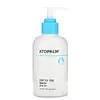What's inside
What's inside
 Key Ingredients
Key Ingredients

 Benefits
Benefits

 Concerns
Concerns

 Ingredients Side-by-side
Ingredients Side-by-side

Water
Skin ConditioningPotassium Cocoyl Glutamate
Disodium Cocoamphodiacetate
CleansingDisodium Lauryl Sulfosuccinate
CleansingDecyl Glucoside
CleansingGlycerin
HumectantBetaine
HumectantSodium Lactate
BufferingCaprylyl Glycol
EmollientPotassium Sorbate
PreservativeCitric Acid
BufferingCitrus Aurantium Amara Fruit Extract
Skin ConditioningLactic Acid
BufferingSodium Hyaluronate
HumectantMyristoyl/Palmitoyl Oxostearamide/Arachamide Mea
Skin ConditioningParfum
MaskingWater, Potassium Cocoyl Glutamate, Disodium Cocoamphodiacetate, Disodium Lauryl Sulfosuccinate, Decyl Glucoside, Glycerin, Betaine, Sodium Lactate, Caprylyl Glycol, Potassium Sorbate, Citric Acid, Citrus Aurantium Amara Fruit Extract, Lactic Acid, Sodium Hyaluronate, Myristoyl/Palmitoyl Oxostearamide/Arachamide Mea, Parfum
Water
Skin ConditioningDisodium Cocoyl Glutamate
CleansingDisodium Cocoamphodiacetate
CleansingPropanediol
SolventGlycerin
HumectantSodium Chloride
MaskingCoco-Glucoside
CleansingXanthan Gum
EmulsifyingSodium Sweetalmondamphoacetate
CleansingMyristoyl/Palmitoyl Oxostearamide/Arachamide Mea
Skin ConditioningSimmondsia Chinensis Seed Oil
EmollientHelianthus Annuus Seed Oil
EmollientVitis Vinifera Seed Oil
EmollientCarthamus Tinctorius Seed Oil
MaskingCamellia Sinensis Seed Oil
HumectantCentella Asiatica Extract
CleansingMadecassoside
AntioxidantCocodimonium Hydroxypropyl Hydrolyzed Wheat Protein
CleansingSodium Phytate
Citric Acid
BufferingSodium Citrate
BufferingHexylene Glycol
Emulsifying1,2-Hexanediol
Skin ConditioningCaprylyl Glycol
EmollientArtemisia Vulgaris Oil
PerfumingSantalum Album Oil
MaskingWater, Disodium Cocoyl Glutamate, Disodium Cocoamphodiacetate, Propanediol, Glycerin, Sodium Chloride, Coco-Glucoside, Xanthan Gum, Sodium Sweetalmondamphoacetate, Myristoyl/Palmitoyl Oxostearamide/Arachamide Mea, Simmondsia Chinensis Seed Oil, Helianthus Annuus Seed Oil, Vitis Vinifera Seed Oil, Carthamus Tinctorius Seed Oil, Camellia Sinensis Seed Oil, Centella Asiatica Extract, Madecassoside, Cocodimonium Hydroxypropyl Hydrolyzed Wheat Protein, Sodium Phytate, Citric Acid, Sodium Citrate, Hexylene Glycol, 1,2-Hexanediol, Caprylyl Glycol, Artemisia Vulgaris Oil, Santalum Album Oil
Ingredients Explained
These ingredients are found in both products.
Ingredients higher up in an ingredient list are typically present in a larger amount.
Caprylyl Glycol is a humectant and emollient, meaning it attracts and preserves moisture.
It is a common ingredient in many products, especially those designed to hydrate skin. The primary benefits are retaining moisture, skin softening, and promoting a healthy skin barrier.
Though Caprylyl Glycol is an alcohol derived from fatty acids, it is not the kind that can dry out skin.
This ingredient is also used as a preservative to extend the life of products. It has slight antimicrobial properties.
Learn more about Caprylyl GlycolCitric Acid is an alpha hydroxy acid (AHA) naturally found in citrus fruits like oranges, lemons, and limes.
Like other AHAs, citric acid can exfoliate skin by breaking down the bonds that hold dead skin cells together. This helps reveal smoother and brighter skin underneath.
However, this exfoliating effect only happens at high concentrations (20%) which can be hard to find in cosmetic products.
Due to this, citric acid is usually included in small amounts as a pH adjuster. This helps keep products slightly more acidic and compatible with skin's natural pH.
In skincare formulas, citric acid can:
While it can provide some skin benefits, research shows lactic acid and glycolic acid are generally more effective and less irritating exfoliants.
Most citric acid used in skincare today is made by fermenting sugars (usually from molasses). This synthetic version is identical to the natural citrus form but easier to stabilize and use in formulations.
Read more about some other popular AHA's here:
Learn more about Citric AcidDisodium Cocoamphodiacetate is a surfactant and helps cleanse skin. It is created from the fatty acids of coconut oil.
Surfactants help rinse oil, dirt, and other pollutants easily from skin. It has a faint fruit-like scent.
Glycerin is already naturally found in your skin. It helps moisturize and protect your skin.
A study from 2016 found glycerin to be more effective as a humectant than AHAs and hyaluronic acid.
As a humectant, it helps the skin stay hydrated by pulling moisture to your skin. The low molecular weight of glycerin allows it to pull moisture into the deeper layers of your skin.
Hydrated skin improves your skin barrier; Your skin barrier helps protect against irritants and bacteria.
Glycerin has also been found to have antimicrobial and antiviral properties. Due to these properties, glycerin is often used in wound and burn treatments.
In cosmetics, glycerin is usually derived from plants such as soybean or palm. However, it can also be sourced from animals, such as tallow or animal fat.
This ingredient is organic, colorless, odorless, and non-toxic.
Glycerin is the name for this ingredient in American English. British English uses Glycerol/Glycerine.
Learn more about GlycerinWe don't have a description for Myristoyl/Palmitoyl Oxostearamide/Arachamide Mea yet.
Water. It's the most common cosmetic ingredient of all. You'll usually see it at the top of ingredient lists, meaning that it makes up the largest part of the product.
So why is it so popular? Water most often acts as a solvent - this means that it helps dissolve other ingredients into the formulation.
You'll also recognize water as that liquid we all need to stay alive. If you see this, drink a glass of water. Stay hydrated!
Learn more about Water